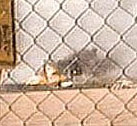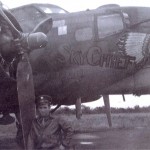
 On July 19, 1989, in the skies over Alta, Iowa, United Airlines Flight 232, on which my great aunt, Gladys Cooper was a passenger, began the fateful journey to a catastrophic end. At 3:16pm, the rear engine’s fan disk broke apart due to a previously undetected metallurgical defect located in a critical area of the titanium-alloy. Basically that meant that the fan disk shattered, sending shrapnel through the hydraulic lines of all three independent hydraulic systems on board the aircraft. This horrific event caused the rapid loss of all the hydraulic fluid. The subsequent catastrophic disintegration of the disk had resulted in a spray of debris with energy levels that exceeded the level of protection provided by design features of the hydraulic systems that operate the DC-10’s flight controls. The flight crew lost its ability to operate nearly all of them. In the resulting crash landing, the right wing just tapped the runway, causing the plane to cartwheel and break apart as it went careening down the runway and into a corn field. While my Great Aunt Gladys was killed in the crash, the skill of the pilot and flight crew saved 185 lives, including their own.
On July 19, 1989, in the skies over Alta, Iowa, United Airlines Flight 232, on which my great aunt, Gladys Cooper was a passenger, began the fateful journey to a catastrophic end. At 3:16pm, the rear engine’s fan disk broke apart due to a previously undetected metallurgical defect located in a critical area of the titanium-alloy. Basically that meant that the fan disk shattered, sending shrapnel through the hydraulic lines of all three independent hydraulic systems on board the aircraft. This horrific event caused the rapid loss of all the hydraulic fluid. The subsequent catastrophic disintegration of the disk had resulted in a spray of debris with energy levels that exceeded the level of protection provided by design features of the hydraulic systems that operate the DC-10’s flight controls. The flight crew lost its ability to operate nearly all of them. In the resulting crash landing, the right wing just tapped the runway, causing the plane to cartwheel and break apart as it went careening down the runway and into a corn field. While my Great Aunt Gladys was killed in the crash, the skill of the pilot and flight crew saved 185 lives, including their own.
While listening to an audio book about World War II, and what happens when bombers flew through flak (Fl(ieger)a(bwehr)k(anone)). I knew that on at least one occasion, my dad, Allen Spencer, a Flight Engineer and Top Turret Gunner on a B-17 in World War II, was tasked with the job of cranking down the landing gear for landing. I don’t know what I had been thinking happened to the landing gear, maybe a close bit of flak the bent something in the gear perhaps, but what had not occurred to me was a catastrophic hit of that flak, causing all hydraulics to be lost. Nevertheless, quite likely that is what happened. It was one of the scenarios discussed in the book. As the hydraulics were lost, the red fluid was all over the floor of the aircraft, and the next thing that was required was to crank down the landing gear, because the gear could not be lowered without hydraulic fluid. Somehow, Dad’s precarious position of hanging out in the open bomb bay doors seemed like such a simple solution to the problem, albeit a heroic act, but the loss of hydraulics could have meant death to the crew. Getting the landing gear down was only part of the problem. What about the flaps, brakes, and such. These planes were in a really bad way.
Of course, my dad’s plane did land safely, given that he became my dad, but years later, when my mother, Collene Spencer’s Aunt Gladys was on a plane crippled by the loss of all hydraulics, I now realize…finally, that when my dad heard about what happened with Flight 232, as we all eventually did, he understood full well, 
 what the flight crew had been faced with. Something I only understood from the view of a spectator…for lack of a better word. He had been there. The Flight 232 situation quite likely took my dad back some 45 years to that day when he had to crank down the landing gear on a B-17 Bomber that had been damaged by flak, probably spilling hydraulic fluid all over the floor where the crew was standing. The experience must have been awful to go through, and the thought of what happened to Flight 232, almost as bad. And yet, in typical World War II veteran style, Dad said nothing, but rather set about comforting his family over the loss.
what the flight crew had been faced with. Something I only understood from the view of a spectator…for lack of a better word. He had been there. The Flight 232 situation quite likely took my dad back some 45 years to that day when he had to crank down the landing gear on a B-17 Bomber that had been damaged by flak, probably spilling hydraulic fluid all over the floor where the crew was standing. The experience must have been awful to go through, and the thought of what happened to Flight 232, almost as bad. And yet, in typical World War II veteran style, Dad said nothing, but rather set about comforting his family over the loss.


Leave a Reply